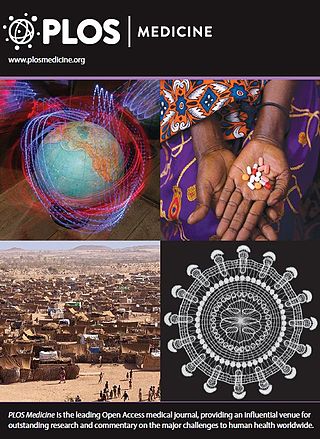
Antiviral drugs are a class of medication used for treating viral infections. Most antivirals target specific viruses, while a broad-spectrum antiviral is effective against a wide range of viruses. Antiviral drugs are one class of antimicrobials, a larger group which also includes antibiotic, antifungal and antiparasitic drugs, or antiviral drugs based on monoclonal antibodies. Most antivirals are considered relatively harmless to the host, and therefore can be used to treat infections. They should be distinguished from virucides, which are not medication but deactivate or destroy virus particles, either inside or outside the body. Natural virucides are produced by some plants such as eucalyptus and Australian tea trees.
The management of HIV/AIDS normally includes the use of multiple antiretroviral drugs as a strategy to control HIV infection. There are several classes of antiretroviral agents that act on different stages of the HIV life-cycle. The use of multiple drugs that act on different viral targets is known as highly active antiretroviral therapy (HAART). HAART decreases the patient's total burden of HIV, maintains function of the immune system, and prevents opportunistic infections that often lead to death. HAART also prevents the transmission of HIV between serodiscordant same sex and opposite sex partners so long as the HIV-positive partner maintains an undetectable viral load.

Aciclovir (ACV), also known as acyclovir, is an antiviral medication. It is primarily used for the treatment of herpes simplex virus infections, chickenpox, and shingles. Other uses include prevention of cytomegalovirus infections following transplant and severe complications of Epstein–Barr virus infection. It can be taken by mouth, applied as a cream, or injected.
Reverse-transcriptase inhibitors (RTIs) are a class of antiretroviral drugs used to treat HIV infection or AIDS, and in some cases hepatitis B. RTIs inhibit activity of reverse transcriptase, a viral DNA polymerase that is required for replication of HIV and other retroviruses.

PLOS Medicine is a peer-reviewed weekly medical journal covering the full spectrum of the medical sciences. It began operation on October 19, 2004, as the second journal of the Public Library of Science (PLOS), a non-profit open access publisher. All content in PLOS Medicine is published under the Creative Commons "by-attribution" license. To fund the journal, the publication's business model requires in most cases that authors pay publication fees. The journal was published online and in a printed format until 2005 and is now only published online. The journal's acting chief editor is Clare Stone, who replaced the previous chief editor, Larry Peiperl, in 2018.
Douglas D. Richman is an American infectious diseases physician and medical virologist. Richman's work has focused on the HIV/AIDS pandemic, since its appearance in the early 1980s. His major contributions have been in the areas of treatment, drug resistance, and pathogenicity.

Foscarnet (phosphonomethanoic acid), known by its brand name Foscavir, is an antiviral medication which is primarily used to treat viral infections involving the Herpesviridae family. It is classified as a pyrophosphate analog DNA polymerase inhibitor. Foscarnet is the conjugate base of a chemical compound with the formula HO2CPO3H2 (Trisodium phosphonoformate).

Raltegravir, sold under the brand name Isentress, is an antiretroviral medication used, together with other medication, to treat HIV/AIDS. It may also be used, as part of post exposure prophylaxis, to prevent HIV infection following potential exposure. It is taken by mouth.

Clinical Microbiology Reviews is a peer-reviewed medical journal covering the areas of clinical microbiology, immunology, medical microbiology, infectious diseases, veterinary microbiology, and microbial pathogenesis. It is a delayed open access journal, full content is accessible via PubMed Central and the journal's website after a 12-month embargo. In April 2015, the journal transitioned to a continuous online publication model. The journal became online-only in January 2018. The final print issue was published in October 2017. According to the Journal Citation Reports, the journal has a 2021 impact factor of 50.129. The journal was established in January 1988. The founding editor was Josephine A. Morello. Editorial board structure changed in 1992 and Morello became editor-in-chief. Betty Ann Forbes was appointed editor-in-chief in 1997. Irving Nachamkin was appointed editor-in-chief in 2002 until 2012. Since 2012, Jo-Anne H. Young has served as editor-in-chief. It is the ninth journal established and published by the American Society for Microbiology.

The British Journal of Pharmacology is a biweekly peer-reviewed medical journal covering all aspects of experimental pharmacology. It is published for the British Pharmacological Society by Wiley-Blackwell. It was established in 1946 as the British Journal of Pharmacology and Chemotherapy. The journal obtained its current title in 1968.

Virology is a peer-reviewed scientific journal in virology. Established in 1955 by George Hirst, Lindsay Black and Salvador Luria, it is the earliest English-only journal to specialize in the field. The journal covers basic research into viruses affecting animals, plants, bacteria and fungi, including their molecular biology, structure, assembly, pathogenesis, immunity, interactions with the host cell, evolution and ecology. Molecular aspects of control and prevention are also covered, as well as viral vectors and gene therapy, but clinical virology is excluded. As of 2013, the journal is published fortnightly by Elsevier.

Antiviral Chemistry & Chemotherapy is a peer-reviewed academic journal published bimonthly by International Medical Press. It was established in January 1990 and published by Blackwell Publishing until 1997. The editor-in-chief is Hugh J. Field. The journal covers research on all aspects of the preclinical development of antiviral drugs, including their chemical synthesis, biochemistry, pharmacology, mode of action, and virology, as well as studies in animal models. The journal is an official publication of the International Society for Antiviral Research.

Clinical Science is a peer-reviewed medical journal that covers all areas of clinical investigation, with a focus on translational science and medicine. The journal is currently published biweekly by Portland Press on behalf of the Biochemical Society.

Antiviral Research is a monthly peer-reviewed medical journal published by Elsevier covering research on all aspects of the development of drugs, vaccines and immunotherapies against viruses of animals and plants. The journal was established in 1981 and is an official publication of the International Society for Antiviral Research. Like other Elsevier publications, it has been accused of limiting access of publicly funded research to rest of the population, including other scientists and researchers. The editor-in-chief is Subhash Vasudevan.

Clinical Cancer Research is a peer-reviewed medical journal on oncology, including the cellular and molecular characterization, prevention, diagnosis, and therapy of human cancer, medical and hematological oncology, radiation therapy, pediatric oncology, pathology, surgical oncology, and clinical genetics. The applications of the disciplines of pharmacology, immunology, cell biology, and molecular genetics to intervention in human cancer are also included. One of the main interests of Clinical Cancer Research is on clinical trials that evaluate new treatments together with research on pharmacology and molecular alterations or biomarkers that predict response or resistance to treatment. Another priority for Clinical Cancer Research is laboratory and animal studies of new drugs as well as molecule-targeted agents with the potential to lead to clinical trials, and studies of targetable mechanisms of oncogenesis, progression of the malignant phenotype, and metastatic disease. The journal is published by the American Association for Cancer Research.
HIV Resistance Response Database Initiative (RDI) is a not-for-profit organisation established in 2002 which states its mission as "To improve the clinical management of HIV infection by developing a large clinical database and bioinformatic techniques that predict accurately any individual's response to any combination of HIV drugs."
The European Journal of Endocrinology is a monthly peer-reviewed medical journal covering endocrinology with a focus on clinical and translational studies, research, and reviews in paediatric and adult endocrinology. It is the clinical journal of the European Society of Endocrinology. The editor-in-chief is Wiebke Arlt. The journal has been published by Bioscientifica since 1999.

Endocrine-Related Cancer is a monthly peer-reviewed medical journal covering cancers in endocrine organs — such as the breast, prostate, pituitary, testes, ovaries, and neuroendocrine system — and hormone-dependent cancers occurring elsewhere in the body. Its scope covers basic, translational, clinical and experimental studies.
Margaret Tisdale was a Welsh-born clinical virologist known for her studies of antiviral resistance in HIV and influenza virus, and for coordinating the development of the anti-influenza drug zanamivir.














